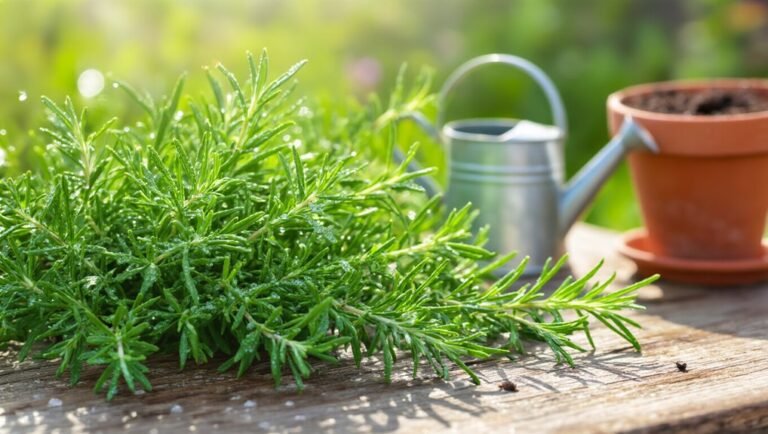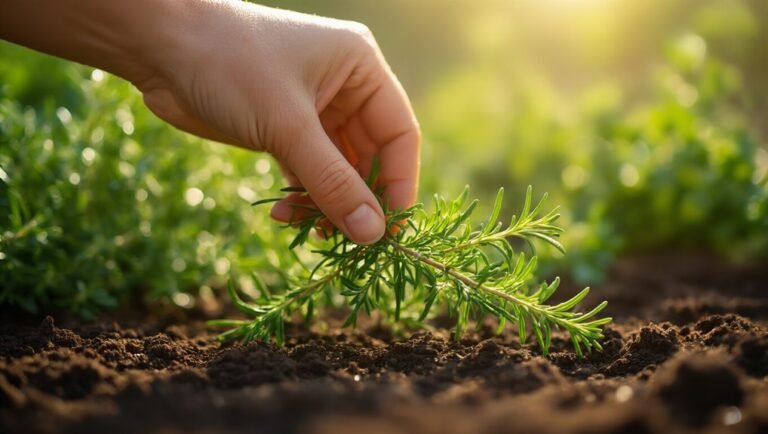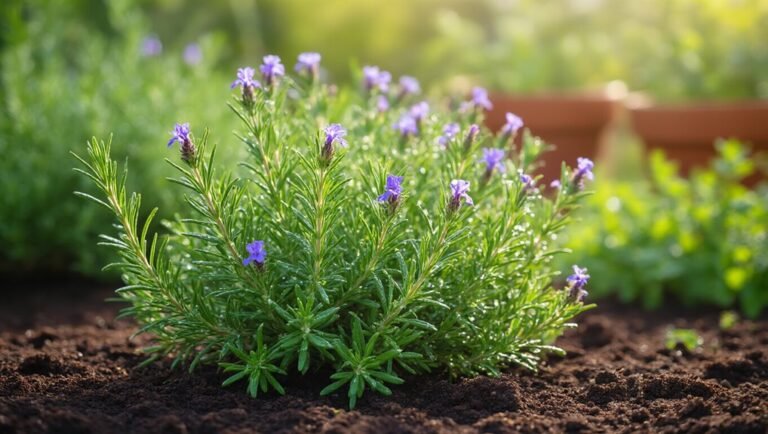To grow fragrant jasmine flowers fast, choose a variety like jasmine sambac that thrives in your climate. Ensure they get at least 6 hours of sunlight and maintain a temperature between 60°F and 75°F. Plant in well-draining soil mixed with organic matter, and water deeply but infrequently to prevent root rot. Regular pruning encourages healthy growth, while feeding them every four to six weeks boosts blooms. Discover more about optimizing your jasmine care for even better results.
Key Takeaways
- Choose a fast-growing jasmine variety, like jasmine sambac, known for its intense fragrance and quicker bloom times.
- Ensure optimal growing conditions by providing at least 6 hours of direct sunlight and maintaining humidity.
- Prepare well-draining, slightly acidic soil by mixing organic matter and loosening it to a depth of 12 inches.
- Plant in spring or early summer, using a balanced, phosphorus-rich fertilizer every four to six weeks for rapid growth.
- Regularly prune and establish a consistent watering schedule to encourage healthy growth and prevent root rot.
Choosing the Right Jasmine Variety
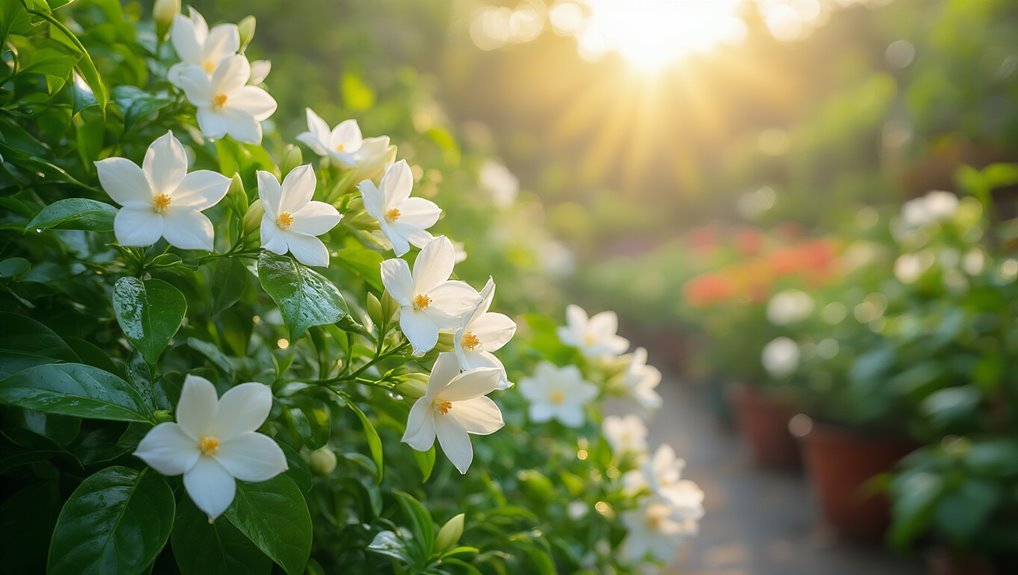
When choosing the right jasmine variety, how do you know which one suits your garden best? Start by considering your climate and space. Some varieties, like Arabian jasmine, thrive in warmer areas, while others, such as winter jasmine, can handle cooler temperatures. Growing jasmine in grow bags can also help manage soil and drainage needs for different varieties, making it easier to accommodate their preferences in your garden.
Think about the growth habit too; do you need a climbing plant or a bushy shrub?
Next, determine how much fragrance you want. Some jasmine types, like jasmine sambac, are known for their intense scent, while others may have a milder aroma.
Lastly, check the bloom time—some jasmine varieties bloom in summer, while others may flower in spring or fall. If you’re interested in growing other fragrant plants, you might enjoy exploring Herb Garden Kits with Seeds and Pots to expand your garden with more aromatic options.
Ideal Growing Conditions for Jasmine
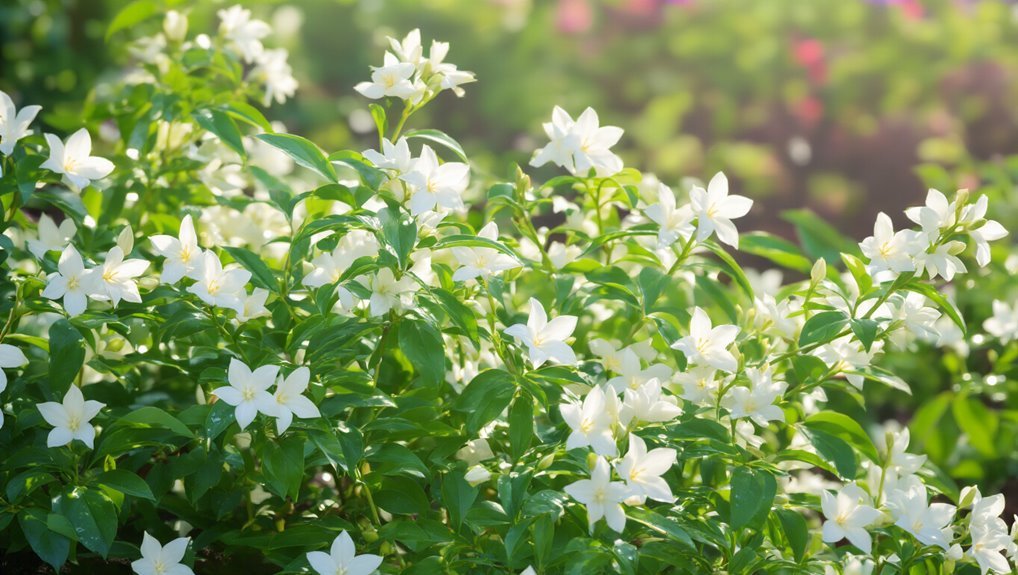
To ensure your jasmine thrives, it’s essential to provide the right growing conditions. Here’s what you need to focus on:
- Light: Jasmine loves full sunlight. Aim for at least 6 hours of direct sunlight daily to encourage healthy growth and abundant blooms.
- Temperature: Keep your jasmine in a warm environment. Ideal temperatures range between 60°F and 75°F (15°C to 24°C). Protect it from cold drafts and frost. For optimal support, using trellis netting helps jasmine vines grow upright and increases airflow around the plant.
- Humidity: Jasmine prefers humid conditions. If your home is dry, consider misting the leaves or placing a humidity tray nearby to keep the air moist.
For the best support and vertical growth, consider training your jasmine on beautiful trellises to enhance both its health and your garden’s appearance.
Preparing the Soil for Planting
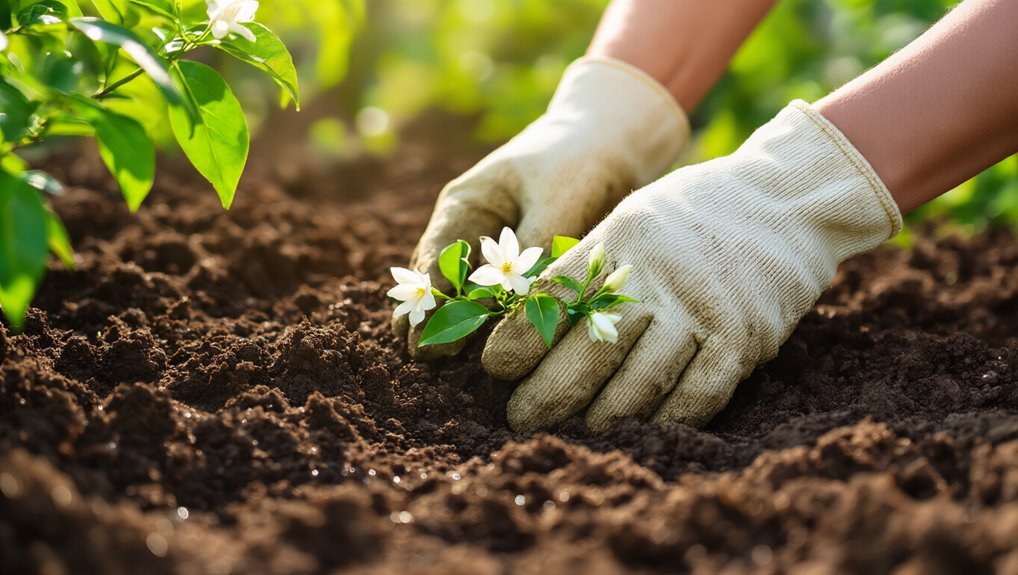
Preparing the soil for planting jasmine is crucial for its health and growth. Start by choosing a well-draining location, as jasmine doesn’t like soggy roots.
Test the soil’s pH; it should be slightly acidic to neutral, ideally between 6.0 and 7.0. If your soil is too heavy or clay-like, mix in organic matter like compost or peat moss to improve drainage and fertility. Using organic mulching materials such as straw can further enrich the soil and help maintain optimal conditions for jasmine.
Remove any weeds or debris, ensuring the area is clean to reduce competition for nutrients. You can also consider adding a slow-release fertilizer to give your jasmine a nutrient boost.
Finally, loosen the soil to about 12 inches deep, ensuring it’s airy and ready for your jasmine plants to thrive. For added moisture retention and weed suppression, applying a layer of mulch around your jasmine can provide extra benefits.
Planting Techniques for Quick Growth
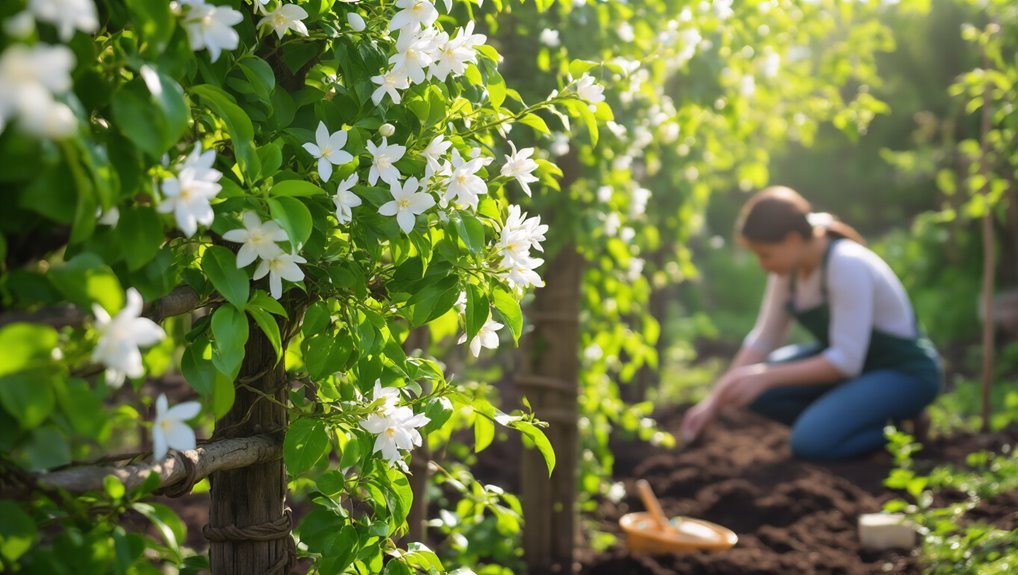
After you’ve set up the soil for your jasmine, it’s time to focus on planting techniques that promote quick growth.
Here are three effective methods to ensure your jasmine thrives:
- Choose the Right Time: Plant your jasmine in spring or early summer when temperatures are warm. This helps the roots establish quickly.
- Dig a Proper Hole: Ensure the hole is twice as wide as the root ball but not deeper. This allows for better drainage and encourages root spread. For even greater success, consider adding plant food to the soil at planting time to nourish your jasmine and support rapid development.
- Position Correctly: Place your jasmine at the same depth it was in the pot. Make sure it gets plenty of sunlight, ideally six hours a day, to boost growth.
Selecting the best garden soil for your jasmine is essential, as quality soil provides the nutrients and structure necessary for healthy, thriving plants.
Watering and Nutrient Requirements
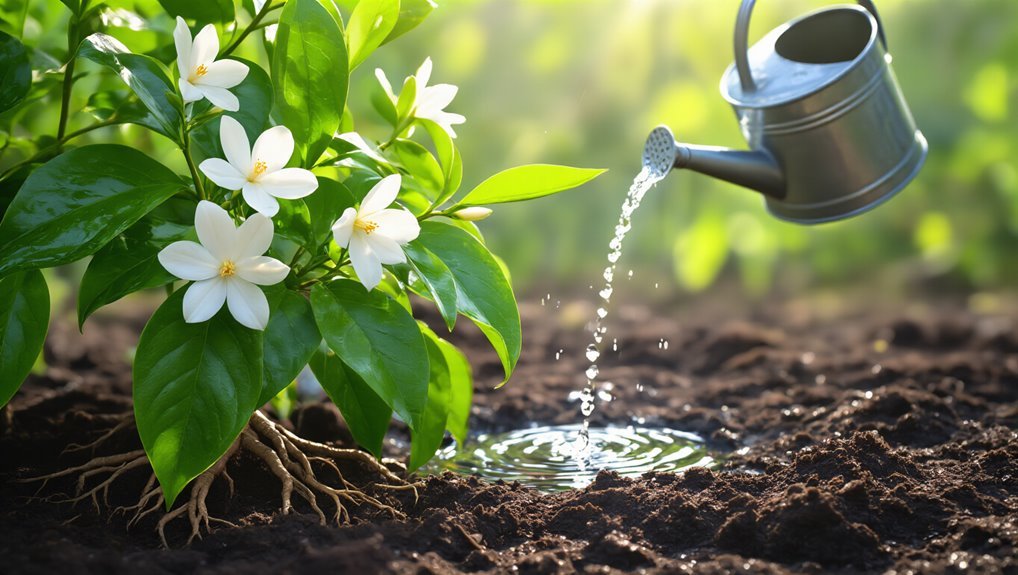
Since jasmine thrives in well-drained soil, it’s crucial to establish a consistent watering schedule that meets its needs.
Water your jasmine deeply but infrequently, allowing the soil to dry out slightly between waterings. This prevents root rot and encourages strong growth. During the growing season, aim for about once a week, adjusting based on weather conditions. For best results, consider trimming your jasmine regularly with pruning shears to encourage healthy new growth and abundant flowering.
In terms of nutrients, use a balanced fertilizer every four to six weeks. A fertilizer high in phosphorus will promote blooming, so look for one with a higher middle number in the N-P-K ratio.
Always follow the package instructions to avoid over-fertilizing, which can damage the plant. With proper watering and nutrient management, your jasmine will flourish and produce fragrant blooms. For an easy and effective way to provide nutrients, consider using plant fertilizer tablets specifically formulated for garden use.
Pruning and Maintenance Tips
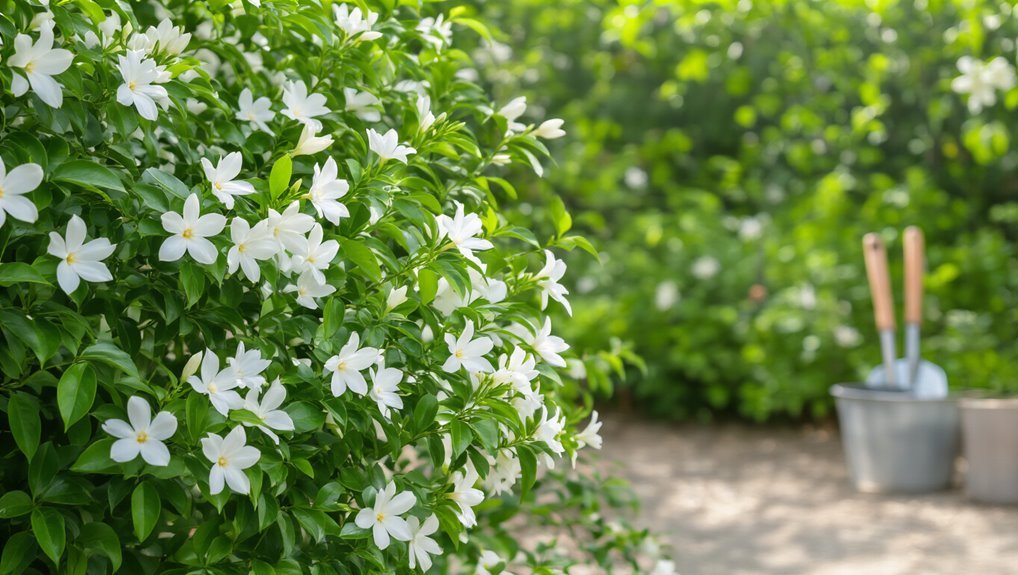
Maintaining your jasmine plants goes hand in hand with proper watering and nutrition. Pruning is essential for promoting healthy growth and abundant blooms. Here are some tips to keep your jasmine thriving:
- Trim Regularly: Cut back overgrown stems in early spring to encourage new growth. Aim for about one-third of the plant’s height. Using the right garden trowel can make soil work around your jasmine much easier and more efficient.
- Remove Dead Leaves: Keep your plants healthy by regularly inspecting for dead leaves or branches. Removing them helps prevent disease and improves airflow.
- Shape the Plant: Use pruning shears to shape your jasmine as it grows. This not only enhances its appearance but also allows sunlight to reach all parts of the plant.
For added protection while pruning, consider wearing gardening gloves to safeguard your hands from thorns and irritants.
Dealing With Pests and Diseases
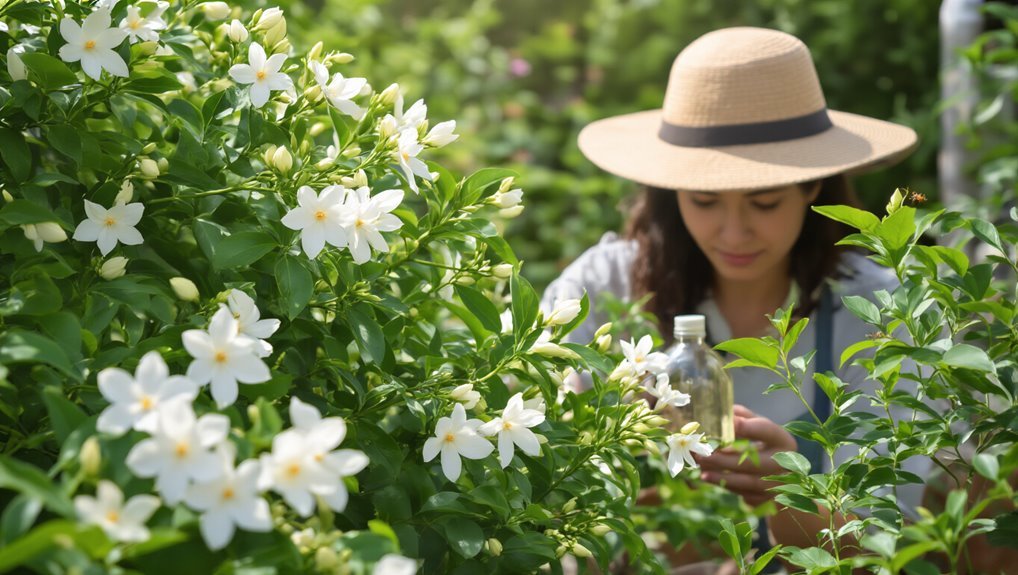
To keep your jasmine flowers vibrant and healthy, it’s crucial to stay vigilant against pests and diseases that can threaten their growth. Regularly inspect your plants for common pests like aphids, spider mites, and whiteflies. If you spot any, act quickly by using insecticidal soap or neem oil to eliminate them without harming your plants. Using organic pest control solutions is an effective and environmentally friendly way to protect your jasmine from harmful insects.
Watch for signs of disease, such as yellowing leaves or wilted stems, which can indicate fungal infections or root rot. Ensure proper drainage and avoid overwatering to minimize these risks.
Keeping your jasmine well-pruned also improves air circulation, reducing the likelihood of disease. With consistent care, you’ll keep your jasmine thriving and free from unwanted intruders. For targeted solutions, consider using pest control products designed specifically to address common jasmine pests and keep your garden healthy.
Harvesting and Enjoying Your Jasmine Blooms
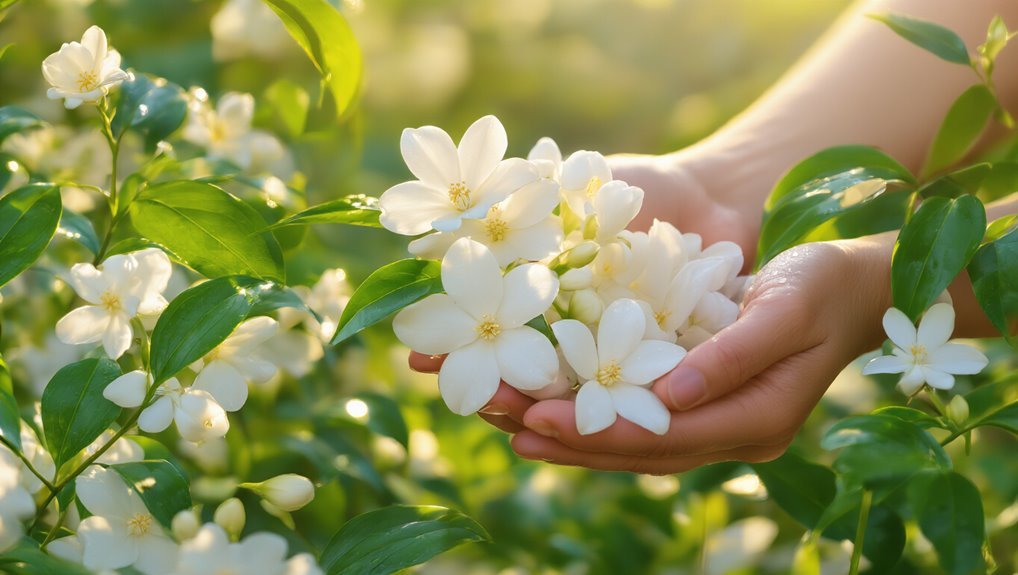
After ensuring your jasmine plants are free from pests and diseases, you can look forward to enjoying their beautiful blooms. For added comfort while tending to your plants, many gardeners use garden kneelers to protect their knees and reduce strain during harvesting.
Harvesting jasmine flowers is a delightful experience, and here’s how to make the most of it:
- Timing: Pick the flowers in the early morning when they’re fully open and fragrant.
- Cutting: Use sharp scissors or shears to snip the stems just above a leaf node, promoting healthy growth.
- Storage: Place your harvested blooms in a vase with water immediately, or refrigerate them for later use.
You can also enjoy the scent by placing them in your living space.
Try making jasmine tea or using the flowers in potpourri. Enjoy the beauty and fragrance of your jasmine blooms!
For a more comfortable and mess-free harvesting experience, consider wearing one of the gardening aprons designed for gardeners, which can help protect your clothing and keep your tools handy.
Frequently Asked Questions
How Long Does It Take for Jasmine to Bloom After Planting?
After planting jasmine, you can expect blooms within 2 to 3 years, depending on the variety and growing conditions. Be patient, care for your plant, and soon you’ll enjoy beautiful, fragrant flowers.
Can Jasmine Be Grown Indoors Successfully?
Yes, you can grow jasmine indoors successfully. Just provide it with bright light, proper humidity, and regular watering. With the right care, you’ll enjoy beautiful blooms and delightful fragrance right in your home.
What Pests Are Most Attracted to Jasmine Plants?
Jasmine plants often attract pests like aphids, spider mites, and whiteflies. You’ll notice their presence through distorted leaves or sticky residue. Regularly inspecting your plants and using insecticidal soap can help keep these pests at bay.
Are There Any Companion Plants for Jasmine?
Imagine your garden as a symphony, where companion plants like marigolds and rosemary harmonize with jasmine. They not only enhance growth but also repel pests, creating a thriving oasis that sings of vibrant beauty and fragrance.
How Do I Propagate Jasmine From Cuttings?
To propagate jasmine from cuttings, you’ll want to take healthy 4-6 inch cuttings, remove lower leaves, and place them in water or moist soil. Keep them warm and humid until roots develop.
Conclusion
By following these tips, you’ll see your jasmine flourish in no time. You might worry that growing fragrant flowers takes too much effort, but with the right variety and care, it’s easier than you think! Just remember to stay consistent with watering and pruning, and before you know it, you’ll have a beautiful, aromatic garden. Enjoy the process, and don’t hesitate to ask for help if you need it—everyone starts somewhere!
